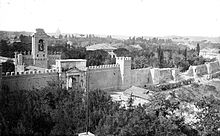Porta Pia
 The internal façade of Porta Pia | |
 Click on the map for a fullscreen view | |
| Coordinates | 41°54′33″N 12°30′4″E / 41.90917°N 12.50111°E |
|---|---|

Porta Pia was one of the northern gates in the Aurelian Walls of Rome, Italy. One of Pope Pius IV's civic improvements to the city, it is named after him. Situated at the end of a new street, the Via Pia, it was designed by Michelangelo to replace the Porta Nomentana situated several hundred meters southwards, which was closed up at the same time. Construction began in 1561 and ended in 1565, after the artist's death. A 1561 bronze commemorative medal by Gian Federico Bonzagna shows an early plan by Michelangelo, very different from his final design.[1] The façade on the outside of the city was completed in 1869 under the Neo-Classicist design by Virginio Vespignani.
History

A replacement was needed because of the new urban area, which could no longer provide access through the ancient Porta Nomentana for the
Most experts consider that Michelangelo was concerned with creating picturesque and dramatic facades to fulfill their important symbolic function as an entrance to Rome. The gate is further emphasized by his positioning of the portal at the end of strada Pia, which resumed the route of the ancient "Alta Semita". It then continues on the current Via XX Settembre, to conclude with an imposing frontal prospect a long straight front beginning at the Quirinal. For a more scenic effect, the gate was set slightly behind the line of the walls, which was connected with two lateral oblique sections of wall, overhung by the wall-ends of the gate, and had only one arch (as it appears on the medal) with the reverse facade facing the city, whereas on the outside was only a simple fornix.
A second arch was opened around 1575 to facilitate the transit of traffic, significantly increased by the closure of the nearby porta Nomentana, as stated on the inscription over the central arch:
PIVS IV PONT MAXPORTAM PIAMSVBLATA NOMENTANA EXTRVXITVIAM PIAM AEQVATA ALTA SEMITA DVXIT
The prints and engravings up to 1577 depict a tower on the outside of a gate – it is doubtful whether this was lost from the design due to a collapse or due to a lessening desire for architectural motifs.

The external facade was completed in 1869 to neoclassical plans by
HIEROMARTYRIBVS MAGNIS ALEXANDRO PONT MAX AGNETI VIRGQVORVM TROPAEIS VIA NOMENTANA NOBILITATVRPIVS IX PONTIFEX MAXIMVS ANNO SACRI PRINC XXIIIPORTAM PIAM NOVIS OPERIBVS COMMVNITAM EXORNATAM DEDICAVITDECESSORI INVICTO SOSPITATRICI SVAEIOSEPHO FERRARIO ANTISTITE VRBANO PRAEFECTO AERARI
It was through an artillery-opened breach in the wall a dozen metres to the west of the gate – known as the "Porta Pia breach" – that on September 20, 1870
Here, on September 11, 1926, the antifascist activist Gino Lucetti threw a bomb against the car transporting Benito Mussolini, but without effect.
See also
- Porta Pinciana – Gate of the Aurelian walls, a landmark of Rome, Italy
- Capture of Rome – Final event of Italian unification (1870)
References
- ^ "Michelangelo: money and medals". Bronze medal of Pius IV, by Gianfederico Bonzagna. Online Tours. British Museum. Archived from the original on August 7, 2008.
- ^ Vasari: "At that time Michelangelo, engaged by the Pope for a design for the Porta Pia, made three, all of them extravagant and beautiful, of which the pope elected to realise the cheapest, as we see today built today, with great praise for him." ("Ricercato a questo tempo Michelagnolo dal Papa per Porta Pia d’un disegno, ne fece tre tutti stravaganti e bellissimi, che ‘l papa elesse per porre in opera quello di minore spesa, come si vede oggi murata, con molta sua lode.")
- ^ These statues were seriously damaged in the bombardment of 1870 and, after long restoration, were relocated in 1929.
External links
- Lucentini, M. (31 December 2012). The Rome Guide: Step by Step through History's Greatest City. Interlink. ISBN 9781623710088.
![]() Media related to Porta Pia at Wikimedia Commons
Media related to Porta Pia at Wikimedia Commons
| Preceded by Porta Nomentana |
Landmarks of Rome Porta Pia |
Succeeded by Porta Pinciana |


